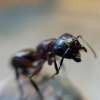Back in Chicagoland, I caught a major flight of C. pennsylvanicus where I was able to collect over 150 queens per hour of searching, as well as several smaller flights that yielded around 30 queens per hour. This was a small forest preserve with large populations of the species, and despite plenty of other ant diversity, this was the only large Camponotus species present there. I would always find the most queens after 8pm and before 11pm, although queens could be found wandering all night, and in founding chambers for months following
Sorry in advance for the question bombardment...
Where there any specific conditions about this forest that made it different?
Was this something that you could find consistently, or just a one-off thing?
Would you say the size of this forest was different?
Could you note any species which also lived in the same area?
Where were you finding the queens? (e.g. on the ground, on trees, digging into logs)
Do you remember any specific details about the forest? (e.g. leaf litter cover, most dominant tree species, soil type, humidity, proximity to wetlands, proximity to urban centers/subrubs)
At most I have been able to collect 5-10 queens per hour of this species, and I have seen as much as 20 per hour. In contrast, some other species I have seen far more queens, and it seems strange that these have been the exception for me.
I understand where your reasoning is, but have you seen massive C. pennsylvanicus flights, or rather queens sporadically like the rest of us?
Yes. But I believe the sparodic flights are due to not entirely ideal flight conditions. Some areas may have just the ideal amount of heat/humidity. About four years ago I tested temperature and humidity within a four mile radius in various locations within those four miles. You would not believe how much it can range. I have it saved somewhere, but some areas sat at 80 something degrees Fahrenheit while other areas weren't even in the mid 70's. On separate days, they all would be at 80's and even 90's. On days like this you would see mass flights. Especially in early June.
I will agree with TC on the sporadic conditions within an area-- it's not a factor I was previously thinking about. Most of the areas near me with large pennsylvanicus populations are within ravines and particularly next to wetlands-- I typically have to select microclimates with warmer temperatures for blacklighting/collecting even within a given forest. Maybe collecting trips during flights are "flat" forests would be more fruitful.
I swear every year I have to add a dozen new factors to whether or not it's a good time/place to look for ants.


















